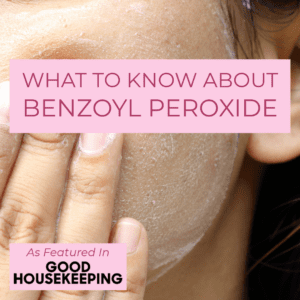What to Know About Benzoyl Peroxide | As Seen in Good Housekeeping
Benzoyl peroxide is a widely used ingredient in cosmetic products, especially for treating acne, thanks to its ability to kill bacteria, reduce inflammation, and keep pores clear. While highly effective, it’s important to understand both its benefits and potential risks and Dr. Mona Foad weighs in on how to carefully incorporate into your routine. Recently, some products containing this ingredient have been recalled, but Good Housekeeping’s article breaks down all the details.

What is benzoyl peroxide used for in cosmetic products?
It’s a popular ingredient for fighting acne. It works by killing acne-causing bacteria, reducing inflammation, and keeping pores clear. You’ll find it in everything from face washes to spot treatments. It’s powerful but can be a little drying, so pairing it with a good moisturizer can help keep your skin balanced.
What is the connection between benzoyl peroxide and benzene?
They might sound similar, but benzoyl peroxide and benzene are not the same. However, there have been concerns about benzoyl peroxide potentially breaking down into benzene. This could happen under certain conditions, like exposure to heat or improper storage. Since benzene is a known carcinogen, it’s important to choose products from reputable brands that test for safety and store them as directed. Make sure to store in a darker cool place and do not use past the expiration date.
Should customers be wary of any products containing benzoyl peroxide?
Benzoyl peroxide is a great acne-fighting ingredient, but it’s not for everyone. If you have sensitive or dry skin, benzoyl peroxide can cause irritation, redness, or peeling. You also have to be careful when applying it and make sure to wash your hands because it can bleach towels and pillowcases. Be sure to wash your hands, or if you apply it at night, use a white pillow case and sheets and do your whites together. Start with a lower strength and use it every other day to see how your skin reacts before going all in.
If you want to choose another product that acts similarly to benzoyl peroxide, what should you look for?
If benzoyl peroxide is too harsh for you, there are some great alternatives. Salicylic acid is another great choice for fighting acne and exfoliating the top layer of skin. If you’re on the more sensitive side, you may opt for products with lactic, mandelic or lactobionic acids instead. Azelaic acid is another option that can help with acne, redness and melasma. Sulfur is an unsung hero that can also fight bacteria but is gentler on the skin. If you want something really mild, niacinamide helps control oil and calm inflammation without causing irritation. It’s all about finding what works best for your skin type.
Can I get benzoyl peroxide over the counter or do I need a prescription?
Oftentimes, doctors combine it with prescription topical antibiotics like clindamycin or erythromycin. Using a combination product has the double benefit of decreasing the bacterial resistance to topical antibiotics. It then also treats the bacteria that can cause acne. There are different formulations with varying strengths, so work with your dermatologist to find the right combination product for your skin type. Also, make sure you discard any unused product after 3 months because they tend to lose their effectiveness.
